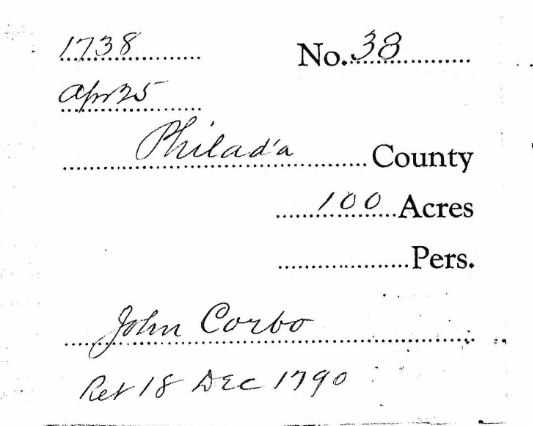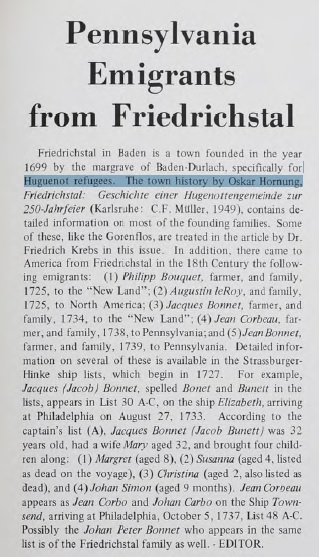A mere six-months after John Corbeau’s arrival in America, a John Corbo received a land warrant in Oley, Philadelphia County, Pennsylvania (on April 25, 1738). According to the survey connected to this land warrant – the property was located in Alsace Township (situated in the Oley Valley) which was positioned in Philadelphia County (now Berks County), Pennsylvania. The Oley Valley was settled in the early 1700s by Germans; French Huguenots; and Swiss a/k/a the Pennsylvania Dutch (“Deutsch”). In fact, it appears that many of the passengers from the Billender Townshend ended up in the Oley Valley as well. The village of Oley has a strong historical past and heritage. In March of 1993, the entire Township was placed on the National Register of Historic Places. According to town history, Alsace Township was said to have been named for the region that the original settlers came from – Alsace, Germany (Alsatian; Elsass; Elsaß – which is now located in eastern France on the border of Germany and Switzerland on the west bank of the Upper Rhine River (present day Alsace, Champagne Ardenne-Lorraine, France). This is very near Friedrichstal – the German village where Jean Corbeau immigrated from. (In order to avoid confusion, it is necessary to understand that many of the eastern regions of France – particularly Alsace-Lorraine – were passed back and forth many times between the feuding French and Germans.)
Getting back to the land transaction involving John Corbo, we know that during this time period a man had to have reached the age of majority – which was 21-years of age. Accordingly, this John Corbo was born at least by 1717 but could have of course been much older.
In researching Colonial Pennsylvania land transactions, I had to familiarize myself with and understand the complicated process that the settlers went through in order to obtain land. In Pennsylvania the initial distribution of land to settlers was a complex process – which thankfully yielded a wealth of information and historical records for us. By way of short background, in 1681, William Penn received a charter from King Charles II which declared him the outright owner of the land that is now known as the State of Pennsylvania. As such, William Penn was given the authority to dispose of the land as he saw fit. The state land office was established in 1682 by William Penn and original deeds and patents were recorded by this office. The administrators and the Commonwealth provided individuals title to land in Pennsylvania through this five-step process:
Application: Under William Penn all requests to purchase acreage at a desired location were made verbally (probably at the land office). Later, under Penn’s heirs, applications were in writing. In the case of John Corbo, his warrant was issued on 25 April 1738, and accordingly, he has no written application on file because, as mentioned, during this earlier period all applications were being made verbally.
Warrant: This is a written order, based on the application, to survey the requested tract of land. John Corbo’s Warrant states that he requested 100 acres of land “situated about two miles from Francis Lanciscees on Oley Hills in Oley Township.” In his Warrant, John Corbo agreed to pay the sum of fifteen pounds and ten shillings for the land and “yearly Quit-rent” of one half penny Sterling for every acre thereof.
Survey: Once the application was made and the warrant issued, a surveyor physically measured and marked the land and prepared a survey.
Return of Survey: After the survey was filed with the land office, the settler was required to make payment on the land. The image below is the Survey attached to John Corbo’s warrant file. This image will make more sense once the Patent is discussed below. The land that belonged to John Corbo is in the upper right hand corner labeled with Phillip Reeser’s name.
 Patent: A Patent was a written first title to the property conveying ownership to the individual submitting the application. Subsequent transactions involving the property were generally conducted on the county level. If and when I locate the pertinent deed, I will update this post should it yield further information on John Corbo. The Patent associated with John Corbo’s land transaction was “returned” 22 Dec 1790, some 52 years after the date of the application, and was shown to convey land to a Henry Reeser. My initial question was whether John Corbo owed the land for 52 years. The chain of title below clears this question up. Once I begin poring over the land Patent, I began to get a clearer picture of how things actually transpired. As it turns out, John Corbo only held the land for nine years – selling it on 1 Apr 1747.
Patent: A Patent was a written first title to the property conveying ownership to the individual submitting the application. Subsequent transactions involving the property were generally conducted on the county level. If and when I locate the pertinent deed, I will update this post should it yield further information on John Corbo. The Patent associated with John Corbo’s land transaction was “returned” 22 Dec 1790, some 52 years after the date of the application, and was shown to convey land to a Henry Reeser. My initial question was whether John Corbo owed the land for 52 years. The chain of title below clears this question up. Once I begin poring over the land Patent, I began to get a clearer picture of how things actually transpired. As it turns out, John Corbo only held the land for nine years – selling it on 1 Apr 1747.
…..there is granted by the said commonwealth unto the said Henry Reeser a certain tract of land called “Plainfield,” situated in Alsace Township, Berks County…….
……in pursuance of a warrant granted to John Corbo dated 25th April 1738 who by deed dated 1 Apr 1747 conveyed the same to Lawrence Hart who by deed dated 9th of July 1748 conveyed the same to Tider Brener & Benjamin Lightfoot Sheriff of said county having taken the same in execution to satisfy the debts of the said Brenor by deed dated 6th Feb 1788 conveyed the same to the said Philip Reeser in fee who conveyed the same to the said Henry Reeser….
Oddly enough, given the abundance of historical records maintained by the State of Pennsylvania, John Corbo appears in no other Pennsylvania record. I have reviewed many, many internet resources and have scoured the Pennsylvania collections of several libraries to no avail. Pennsylvania has marriage and probate records dating as early as 1682; church records as early as the 1730s; and naturalization records as early as about 1740. (Note – tax records for the property mentioned above in Oley Township are not available until 1758 – over eleven years after John sold his property.) John Corbo appears in none of the available records. As always, the constant misspelling of the surname makes researching the Curbow family extremely difficult. While searching for records, I found a John Cambree present in Philadelphia County in 1744; a Eberhard Karboe (with Christina C. Zink) present in Philadelphia county in 1753; a Solomon Kirby, a Nathaniel Kirby – both known Curbow first names; a John Coble; and a John Carbough of York County, Pennsylvania. None seem to be our John Corbo or seem to be connected to him. What happened to John Corbo of Philadelphia County, Pennsylvania? Why is there no record for him after the sale of his land in 1747? Did he die young? More likely to me – he followed the German migration pattern and left the area. Stay tuned for – John Corbo of Maryland.
QUESTION: We have established that the John Corbeau of Freichstals, Germany and the Jean Corbeau that arrived in Philadelphia in 1737 is one and the same person. Now – is the German/French immigrant John Corbeau and the Pennsylvania land owner John Corbo one and the same person?









